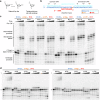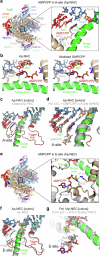Cryo-EM uncovers a sequential mechanism for RNA polymerase I pausing and stalling at abasic DNA lesions
- PMID: 40480971
- PMCID: PMC12144180
- DOI: 10.1038/s41467-025-60536-4
Cryo-EM uncovers a sequential mechanism for RNA polymerase I pausing and stalling at abasic DNA lesions
Abstract
During synthesis of the ribosomal RNA precursor, RNA polymerase I (Pol I) monitors DNA integrity but its response to DNA damage remains poorly studied. Abasic sites are among the most prevalent DNA lesions in eukaryotic cells, and their detection is critical for cell survival. We report cryo-EM structures of Pol I in different stages of stalling at abasic sites, supported by in vitro transcription studies. Slow nucleotide addition opposite abasic sites occurs through base sandwiching between the RNA 3'-end and the Pol I bridge helix. Templating abasic sites can also cause Pol I cleft opening, which enables the A12 subunit to access the active center. Nucleotide addition opposite the lesion induces a translocation intermediate where DNA bases tilt to form hydrogen bonds with the new RNA base. These findings reveal unique mechanisms of Pol I stalling at abasic sites, differing from arrest by bulky lesions or abasic site handling by RNA polymerase II.
© 2025. The Author(s).
Conflict of interest statement
Competing interests: The authors declare no competing interest.
Figures







Similar articles
-
Structural basis of transcriptional stalling and bypass of abasic DNA lesion by RNA polymerase II.Proc Natl Acad Sci U S A. 2018 Mar 13;115(11):E2538-E2545. doi: 10.1073/pnas.1722050115. Epub 2018 Feb 27. Proc Natl Acad Sci U S A. 2018. PMID: 29487211 Free PMC article.
-
Structural basis of RNA polymerase I stalling at UV light-induced DNA damage.Proc Natl Acad Sci U S A. 2018 Sep 4;115(36):8972-8977. doi: 10.1073/pnas.1802626115. Epub 2018 Aug 20. Proc Natl Acad Sci U S A. 2018. PMID: 30127008 Free PMC article.
-
Molecular insight into RNA polymerase I promoter recognition and promoter melting.Nat Commun. 2019 Dec 5;10(1):5543. doi: 10.1038/s41467-019-13510-w. Nat Commun. 2019. PMID: 31804486 Free PMC article.
-
Structural and biochemical analysis of DNA lesion-induced RNA polymerase II arrest.Methods. 2019 Apr 15;159-160:29-34. doi: 10.1016/j.ymeth.2019.02.019. Epub 2019 Feb 22. Methods. 2019. PMID: 30797902 Free PMC article. Review.
-
Synthesis of the ribosomal RNA precursor in human cells: mechanisms, factors and regulation.Biol Chem. 2023 Jul 17;404(11-12):1003-1023. doi: 10.1515/hsz-2023-0214. Print 2023 Oct 26. Biol Chem. 2023. PMID: 37454246 Review.
References
-
- Lindahl, T. Instability and decay of the primary structure of DNA. Nature362, 709–715 (1993). - PubMed
-
- Loeb, L. A. & Preston, B. D. Mutagenesis by apurinic/apyrimidinic sites. Annu. Rev. Genet.20, 201–230 (1986). - PubMed
-
- Strauss, B. S. The ‘A rule’ of mutagen specificity: a consequence of DNA polymerase bypass of non-instructional lesions?. BioEssays13, 79–84 (1991). - PubMed
-
- Zahn, K. E., Belrhali, H., Wallace, S. S. & Doublié, S. Caught bending the A-rule: crystal structures of translesion DNA synthesis with a non-natural nucleotide. Biochemistry46, 10551–10561 (2007). - PubMed
MeSH terms
Substances
Grants and funding
LinkOut - more resources
Full Text Sources

